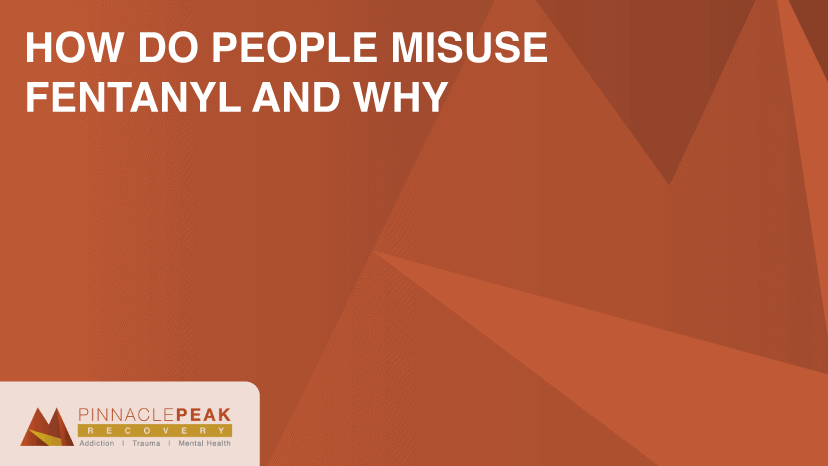Fentanyl Exposure

You’re scrolling through your Facebook feed when you stumble upon a post that catches your eye. It talks about a story from a friend of a friend who was almost kidnapped because she sat on a public toilet that had fentanyl on it. The friend urges others to share the story and be cautious of public restrooms. Is this true? Can things like that actually happen? Do you need to worry about fentanyl exposure in your day-to-day life?
Stories and rumors similar to the one above pop up on the internet on a regular basis. While not all of them relate to fentanyl specifically, it’s always important to do your research to make sure the information is coming from a trusted source. While being cautious is rarely a bad thing, fearmongering or inducing panic through stories like these isn’t beneficial.
Our team here at Pinnacle Peak Recovery has a long history of helping people recover from substance use. Our history in the field combined with our master-level physicians means we have a good grasp on substances, how they work, and the dangers they might present. Since 2022, Arizona residents have been commonly googling “fentanyl” and trying to learn more about it. Today we’re going to talk about fentanyl exposure, how it can happen, and how concerned you should be about it.
Accidentally Absorbing Fentanyl Through the Skin Is Not Likely
One of the biggest concerns we hear about fentanyl exposure is regarding skin contact. So, is touching fentanyl something to be concerned about?
The short answer is no. If you're exposed to fentanyl in a consumable form and you accidentally touch it, you're not likely to experience side effects or be impacted by it at all. It is important to note that if you know you've been in contact with fentanyl, it's advised to go wash the area off and not touch your face or use the bathroom before doing so. Make sure you use soap and water and not alcohol-based hand sanitizer. Fentanyl on its own is very unlikely to absorb past your skin barrier, but alcohol-based products could increase absorption instead of washing it off.
Many people also worry about fentanyl patches. The story we spoke about above is similar to a story that was recently spread on social media. Can you come into contact with a fentanyl patch without knowing? If you did, how quickly would it impact you?
Fentanyl patches are a prescription medication that helps people manage severe pain. These patches usually last for about 72 hours before a person needs to change them. While they are clear, making them harder to see, the odds of you encountering one or becoming incapacitated because of one are very low. Not only would it take a long time for the drug to take any effect, but there has been minimal to no evidence to suggest that they’re being utilized in this way. The most common concern with fentanyl patches is actually exposure for young children.
So what should you be concerned about when it comes to fentanyl exposure?

The Real Dangers of Being Exposed to Fentanyl
The most prominent concern with fentanyl is accidental ingestion. This most commonly happens when someone takes a substance like cocaine or meth without knowing that it has been laced with fentanyl. This often leads to an increased chance of overdosing.
What about if you find a white powder in your house? Maybe you stumbled upon a hidden Ziploc bag that's full of a substance you don't know. What if it's fentanyl? How can you tell?
Can Inhaling Fentanyl Cause an Overdose?
If you stumble across an unknown powder in your home, you don't need to worry about the dangers to you if it stays inside the bag. Accidental physical contact has an incredibly low chance of even producing side effects.
Where you should be concerned, however, is if you accidentally inhale it.
Fentanyl can only impact you if it's absorbed into the body. The fastest way a person can do this is through direct injection. The second fastest way is through inhalation. If you think you've accidentally inhaled fentanyl, leave the space it's in and seek medical help.
Can Accidental Exposure to Fentanyl Cause Side Effects?
There are a few ways that you can be exposed to fentanyl without realizing it. The majority of these occur due to unintentionally ingesting it in some way, shape, or form. The CDC recommends that you do not eat, drink, smoke, or use the bathroom in an area that is known to have powdered fentanyl within it.
Ultimately, your chances of experiencing any sort of life-threatening side effects from this type of exposure are low. This doesn’t mean you shouldn’t be aware or cautious in situations that call for it.
Overall, if you or a loved one is regularly partaking in opioids, or they have an opioid prescription, it’s smart to keep Naloxone on hand just in case.
What to Do if a Child Is Exposed to Fentanyl
Due to fentanyl’s extreme potency, if a child is exposed to it they are much more likely to experience complications because their bodies are so much smaller. If you think your child might have been exposed to or accidentally ingested fentanyl, call for medical help immediately.
Children can easily die of a fentanyl overdose if they accidentally ingest it. If you or a loved one uses a fentanyl patch, the FDA recommends you take extra care to ensure it doesn’t fall off your body or come into direct contact with young children or infants while they’re being held. They suggest covering patches with transparent, adhesive film to help better secure them and prevent the medication from coming into contact with your child’s skin.

The Symptoms to Look For if You’re Exposed to Fentanyl
Depending on the type of fentanyl exposure you experienced, the severity and timeline of the side effects you might have will vary. Let’s look at some of the signs you can look out for regarding fentanyl exposure:
- Nausea
- Euphoria
- Drowsiness and fatigue
- Confusion
- Constipation
- Impaired balance
- Drop in blood pressure
- Dizziness
- Indigestion and diarrhea
- Headaches
- Slurred speech
Additionally, knowing the signs of an overdose is incredibly important. Opioid overdoses have only been on the rise in recent years. Within the past year, there have been nearly 4,000 deaths related to opioids, 7,400 non-fatal overdoses, and over 18,000 emergency room visits relating to opioid use. Opioid overdoses, which include fentanyl, can be helped with the use of Naloxone. Naloxone works to block opioid receptors and helps keep people alive long enough for medical help to arrive.
Someone who is overdosing will often be slow to respond, have blue-tinting starting on their skin, have slowed breathing, and might complain of chest pain. Other common fentanyl side effects include unconsciousness and seizures. If you notice these signs in yourself or another person, don’t be afraid to call for medical help. In the state of Arizona, the Good Samaritan Law helps prevent you from being legally prosecuted when seeking medical help for an overdose.
Our team here at Pinnacle Peak Recovery knows the many ways opioids, fentanyl, and other substance use can impact you and those around you. Recovery can sometimes seem like a difficult or even impossible task, but it’s not. We’re ready to help you no matter what your history is with substance use or recovery. Whether it’s your first time taking that step or your tenth, we have evidence-based fentanyl treatment that we work to tailor to our patients because we know no singular treatment plan fits every individual. We want to work with you to help you reach your healing goals.
If you have any questions about opioids, fentanyl, Naloxone, or anything else, we’re here to help. You can give us a call anytime at (866) 377-4761. Here at Pinnacle Peak, we’re going to give you the best treatment we can because we want everyone in our community to thrive.
Take The First Step Towards Healing From Fentanyl Addiction
Call Us Today!
FAQs
What if you are exposed to fentanyl?
If you simply made physical contact with fentanyl, there is no need to panic. Make sure you go wash off the exposed area with soap and water and you will be just fine. Afterwards, make sure you contact a doctor or poison control just to make sure everything is okay.
What are the symptoms of fentanyl exposure in humans?
If you ingested fentanyl without knowing, some of the side effects include confusion, dizziness, euphoria, headaches, slurred speech, balance impairment, lowered blood pressure, reduced appetite, nausea, and constipation.
How long does it take for fentanyl to get into your skin?
It is not easy for powder forms of fentanyl to get past the barrier of your skin on its own. Fentanyl patches take hours or even up to a full day for the effects to be felt.



